Financial Fraud Detection Techniques
VerifiedAdded on 2020/03/04
|14
|3001
|117
AI Summary
This assignment presents a comprehensive review of literature focused on detecting financial fraud using data mining techniques. It delves into various methods employed, including social network analysis, and highlights relevant case studies to illustrate the practical applications of these techniques in combating financial crime.
Contribute Materials
Your contribution can guide someone’s learning journey. Share your
documents today.
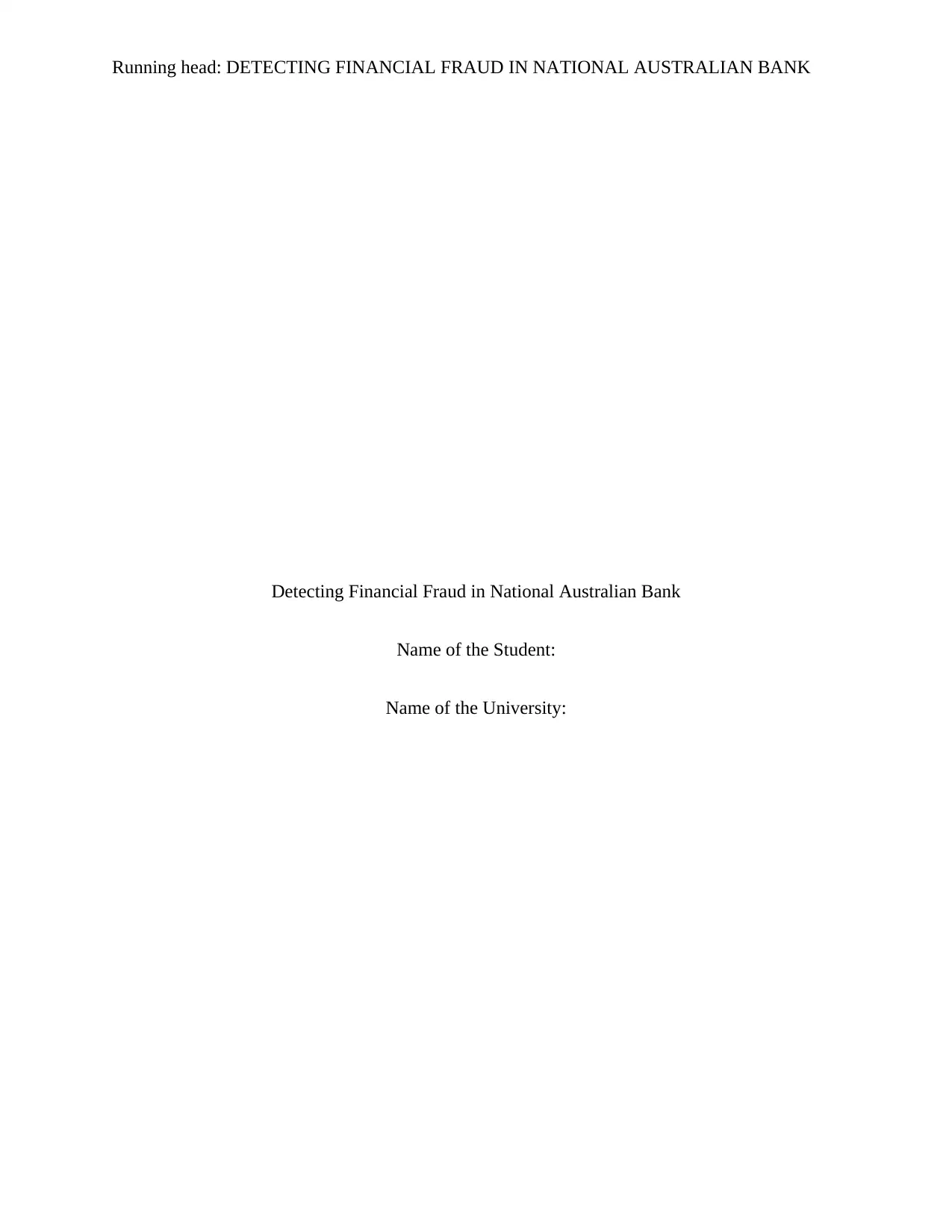
Running head: DETECTING FINANCIAL FRAUD IN NATIONAL AUSTRALIAN BANK
Detecting Financial Fraud in National Australian Bank
Name of the Student:
Name of the University:
Detecting Financial Fraud in National Australian Bank
Name of the Student:
Name of the University:
Secure Best Marks with AI Grader
Need help grading? Try our AI Grader for instant feedback on your assignments.

1DETECTING FINANCIAL FRAUD IN NATIONAL AUSTRALIAN BANK
Abstract
This project proposal provides a project on data mining which is focused on detection of
financial fraud into the National Australian Bank. This particular document discusses on data
mining tools and techniques used to detect the frauds. With use of CRISP-DM methodology, the
data mining techniques and tools are analyzed to detect the problems. Data sources are also
described for customer transaction, investment services and credit transactions.
Abstract
This project proposal provides a project on data mining which is focused on detection of
financial fraud into the National Australian Bank. This particular document discusses on data
mining tools and techniques used to detect the frauds. With use of CRISP-DM methodology, the
data mining techniques and tools are analyzed to detect the problems. Data sources are also
described for customer transaction, investment services and credit transactions.
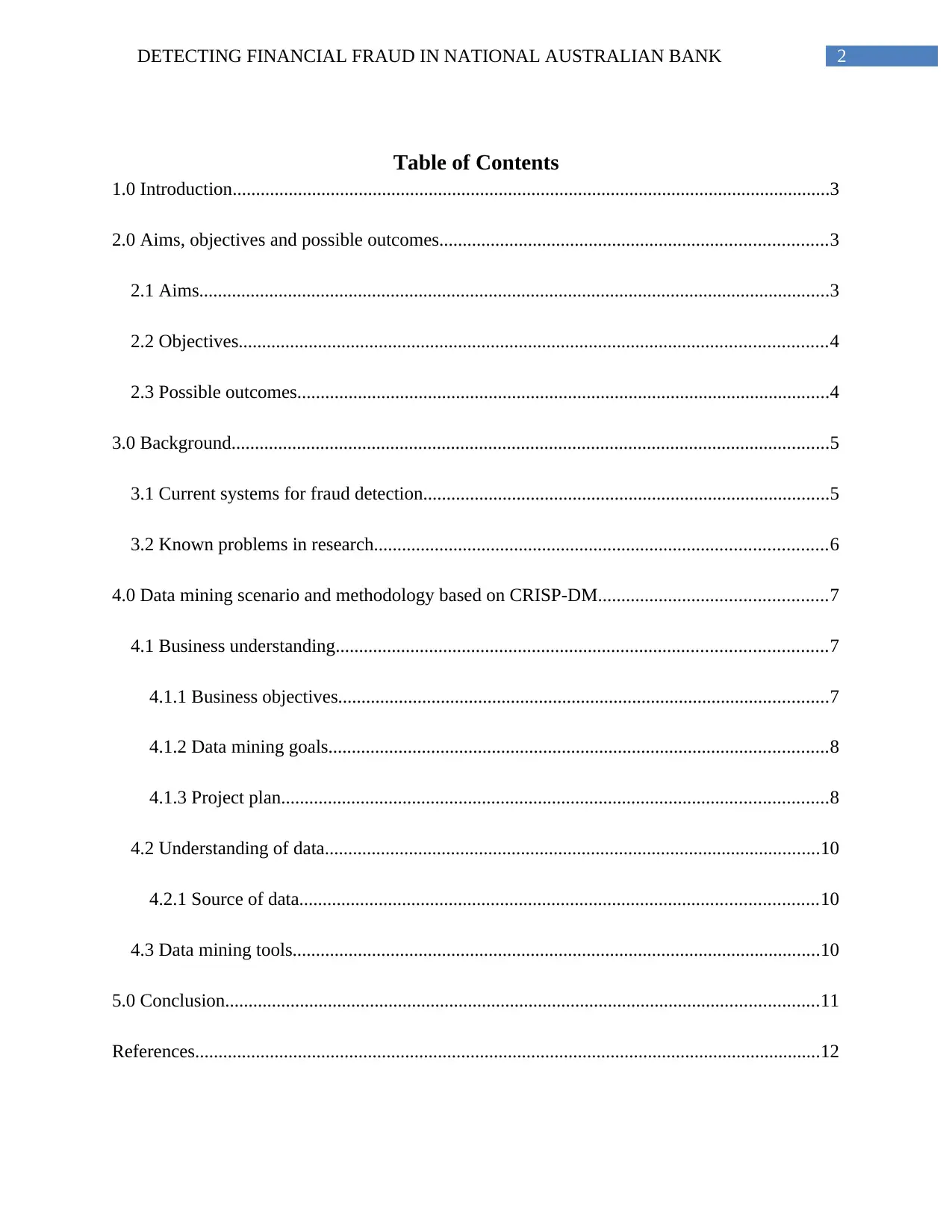
2DETECTING FINANCIAL FRAUD IN NATIONAL AUSTRALIAN BANK
Table of Contents
1.0 Introduction................................................................................................................................3
2.0 Aims, objectives and possible outcomes...................................................................................3
2.1 Aims.......................................................................................................................................3
2.2 Objectives..............................................................................................................................4
2.3 Possible outcomes..................................................................................................................4
3.0 Background................................................................................................................................5
3.1 Current systems for fraud detection.......................................................................................5
3.2 Known problems in research.................................................................................................6
4.0 Data mining scenario and methodology based on CRISP-DM.................................................7
4.1 Business understanding.........................................................................................................7
4.1.1 Business objectives.........................................................................................................7
4.1.2 Data mining goals...........................................................................................................8
4.1.3 Project plan.....................................................................................................................8
4.2 Understanding of data..........................................................................................................10
4.2.1 Source of data...............................................................................................................10
4.3 Data mining tools.................................................................................................................10
5.0 Conclusion...............................................................................................................................11
References......................................................................................................................................12
Table of Contents
1.0 Introduction................................................................................................................................3
2.0 Aims, objectives and possible outcomes...................................................................................3
2.1 Aims.......................................................................................................................................3
2.2 Objectives..............................................................................................................................4
2.3 Possible outcomes..................................................................................................................4
3.0 Background................................................................................................................................5
3.1 Current systems for fraud detection.......................................................................................5
3.2 Known problems in research.................................................................................................6
4.0 Data mining scenario and methodology based on CRISP-DM.................................................7
4.1 Business understanding.........................................................................................................7
4.1.1 Business objectives.........................................................................................................7
4.1.2 Data mining goals...........................................................................................................8
4.1.3 Project plan.....................................................................................................................8
4.2 Understanding of data..........................................................................................................10
4.2.1 Source of data...............................................................................................................10
4.3 Data mining tools.................................................................................................................10
5.0 Conclusion...............................................................................................................................11
References......................................................................................................................................12
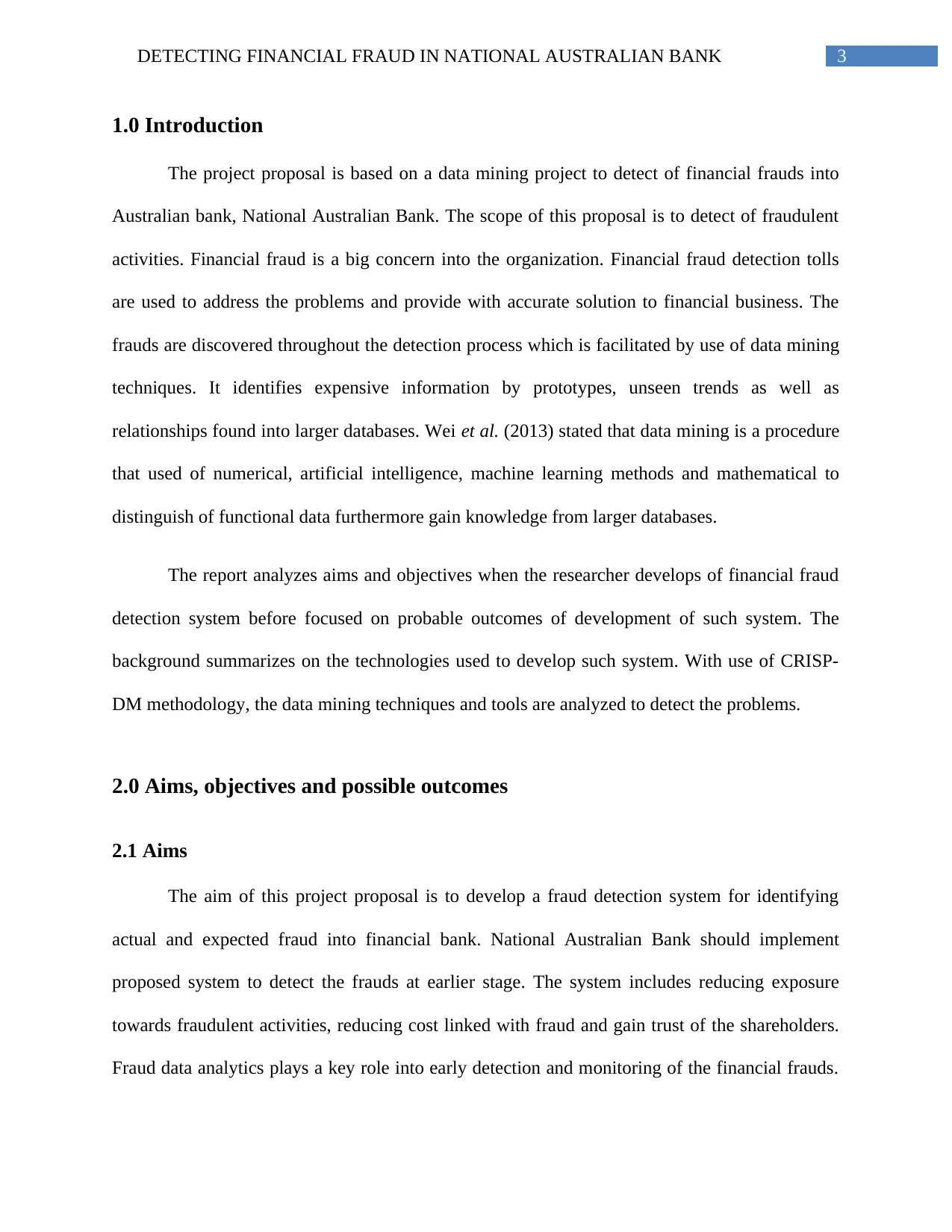
3DETECTING FINANCIAL FRAUD IN NATIONAL AUSTRALIAN BANK
1.0 Introduction
The project proposal is based on a data mining project to detect of financial frauds into
Australian bank, National Australian Bank. The scope of this proposal is to detect of fraudulent
activities. Financial fraud is a big concern into the organization. Financial fraud detection tolls
are used to address the problems and provide with accurate solution to financial business. The
frauds are discovered throughout the detection process which is facilitated by use of data mining
techniques. It identifies expensive information by prototypes, unseen trends as well as
relationships found into larger databases. Wei et al. (2013) stated that data mining is a procedure
that used of numerical, artificial intelligence, machine learning methods and mathematical to
distinguish of functional data furthermore gain knowledge from larger databases.
The report analyzes aims and objectives when the researcher develops of financial fraud
detection system before focused on probable outcomes of development of such system. The
background summarizes on the technologies used to develop such system. With use of CRISP-
DM methodology, the data mining techniques and tools are analyzed to detect the problems.
2.0 Aims, objectives and possible outcomes
2.1 Aims
The aim of this project proposal is to develop a fraud detection system for identifying
actual and expected fraud into financial bank. National Australian Bank should implement
proposed system to detect the frauds at earlier stage. The system includes reducing exposure
towards fraudulent activities, reducing cost linked with fraud and gain trust of the shareholders.
Fraud data analytics plays a key role into early detection and monitoring of the financial frauds.
1.0 Introduction
The project proposal is based on a data mining project to detect of financial frauds into
Australian bank, National Australian Bank. The scope of this proposal is to detect of fraudulent
activities. Financial fraud is a big concern into the organization. Financial fraud detection tolls
are used to address the problems and provide with accurate solution to financial business. The
frauds are discovered throughout the detection process which is facilitated by use of data mining
techniques. It identifies expensive information by prototypes, unseen trends as well as
relationships found into larger databases. Wei et al. (2013) stated that data mining is a procedure
that used of numerical, artificial intelligence, machine learning methods and mathematical to
distinguish of functional data furthermore gain knowledge from larger databases.
The report analyzes aims and objectives when the researcher develops of financial fraud
detection system before focused on probable outcomes of development of such system. The
background summarizes on the technologies used to develop such system. With use of CRISP-
DM methodology, the data mining techniques and tools are analyzed to detect the problems.
2.0 Aims, objectives and possible outcomes
2.1 Aims
The aim of this project proposal is to develop a fraud detection system for identifying
actual and expected fraud into financial bank. National Australian Bank should implement
proposed system to detect the frauds at earlier stage. The system includes reducing exposure
towards fraudulent activities, reducing cost linked with fraud and gain trust of the shareholders.
Fraud data analytics plays a key role into early detection and monitoring of the financial frauds.
Secure Best Marks with AI Grader
Need help grading? Try our AI Grader for instant feedback on your assignments.
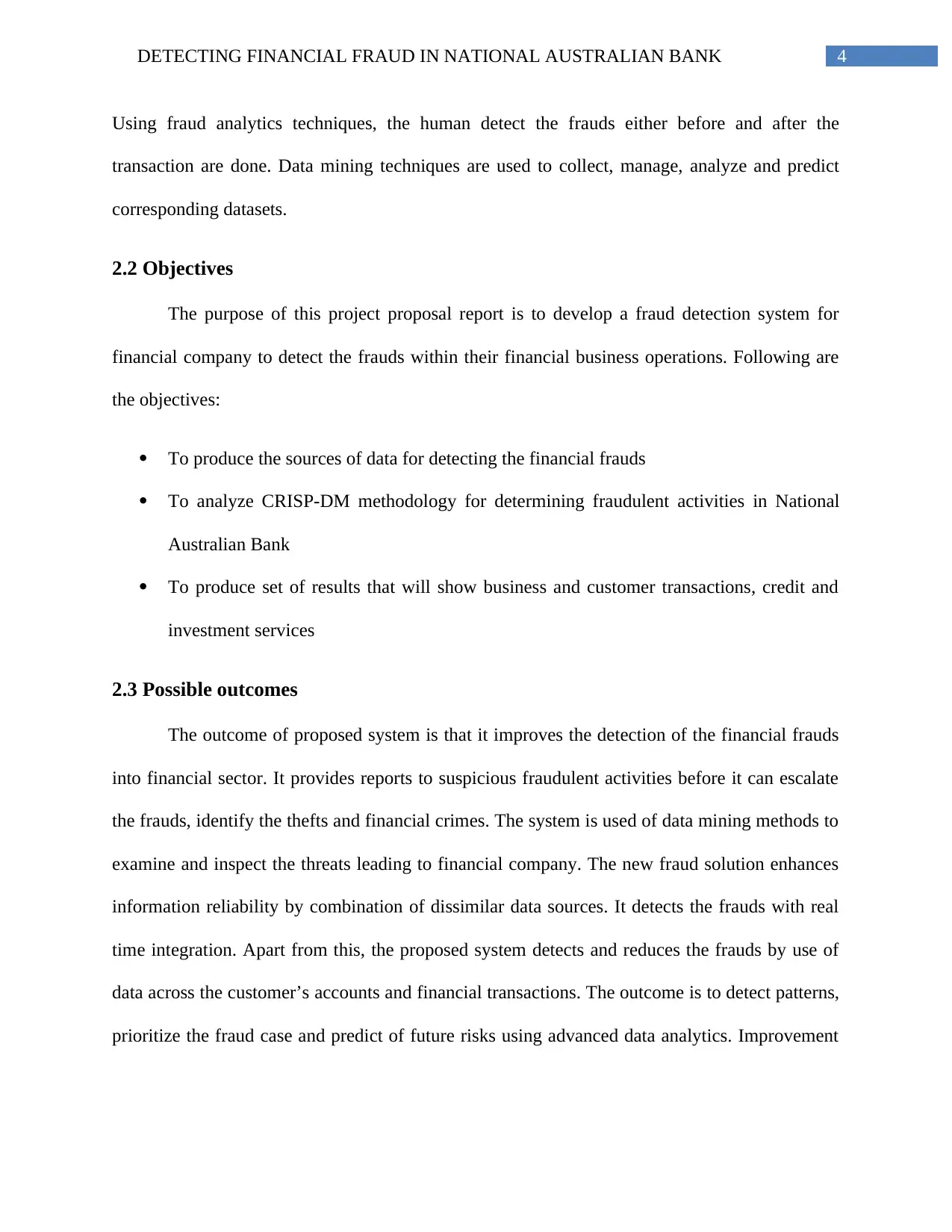
4DETECTING FINANCIAL FRAUD IN NATIONAL AUSTRALIAN BANK
Using fraud analytics techniques, the human detect the frauds either before and after the
transaction are done. Data mining techniques are used to collect, manage, analyze and predict
corresponding datasets.
2.2 Objectives
The purpose of this project proposal report is to develop a fraud detection system for
financial company to detect the frauds within their financial business operations. Following are
the objectives:
To produce the sources of data for detecting the financial frauds
To analyze CRISP-DM methodology for determining fraudulent activities in National
Australian Bank
To produce set of results that will show business and customer transactions, credit and
investment services
2.3 Possible outcomes
The outcome of proposed system is that it improves the detection of the financial frauds
into financial sector. It provides reports to suspicious fraudulent activities before it can escalate
the frauds, identify the thefts and financial crimes. The system is used of data mining methods to
examine and inspect the threats leading to financial company. The new fraud solution enhances
information reliability by combination of dissimilar data sources. It detects the frauds with real
time integration. Apart from this, the proposed system detects and reduces the frauds by use of
data across the customer’s accounts and financial transactions. The outcome is to detect patterns,
prioritize the fraud case and predict of future risks using advanced data analytics. Improvement
Using fraud analytics techniques, the human detect the frauds either before and after the
transaction are done. Data mining techniques are used to collect, manage, analyze and predict
corresponding datasets.
2.2 Objectives
The purpose of this project proposal report is to develop a fraud detection system for
financial company to detect the frauds within their financial business operations. Following are
the objectives:
To produce the sources of data for detecting the financial frauds
To analyze CRISP-DM methodology for determining fraudulent activities in National
Australian Bank
To produce set of results that will show business and customer transactions, credit and
investment services
2.3 Possible outcomes
The outcome of proposed system is that it improves the detection of the financial frauds
into financial sector. It provides reports to suspicious fraudulent activities before it can escalate
the frauds, identify the thefts and financial crimes. The system is used of data mining methods to
examine and inspect the threats leading to financial company. The new fraud solution enhances
information reliability by combination of dissimilar data sources. It detects the frauds with real
time integration. Apart from this, the proposed system detects and reduces the frauds by use of
data across the customer’s accounts and financial transactions. The outcome is to detect patterns,
prioritize the fraud case and predict of future risks using advanced data analytics. Improvement
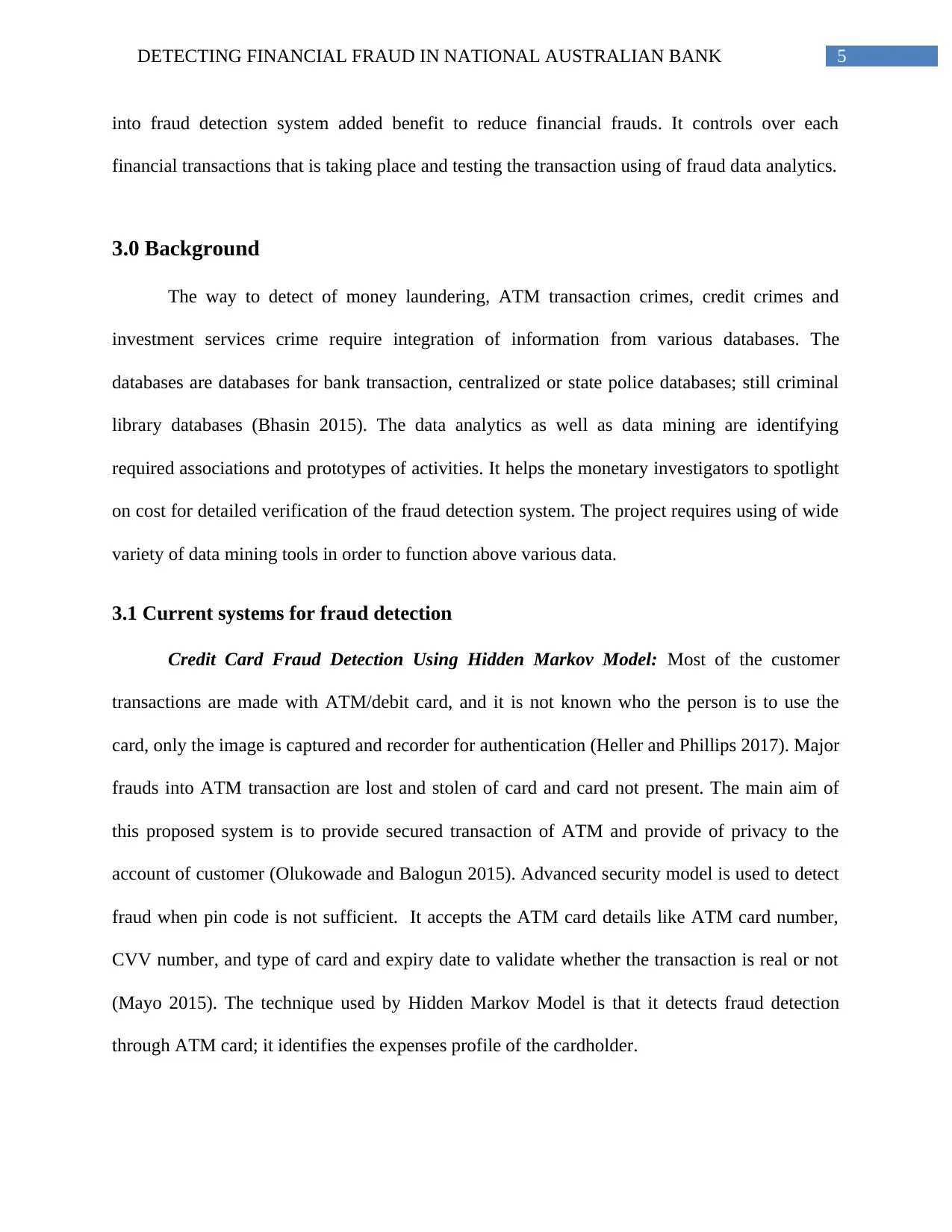
5DETECTING FINANCIAL FRAUD IN NATIONAL AUSTRALIAN BANK
into fraud detection system added benefit to reduce financial frauds. It controls over each
financial transactions that is taking place and testing the transaction using of fraud data analytics.
3.0 Background
The way to detect of money laundering, ATM transaction crimes, credit crimes and
investment services crime require integration of information from various databases. The
databases are databases for bank transaction, centralized or state police databases; still criminal
library databases (Bhasin 2015). The data analytics as well as data mining are identifying
required associations and prototypes of activities. It helps the monetary investigators to spotlight
on cost for detailed verification of the fraud detection system. The project requires using of wide
variety of data mining tools in order to function above various data.
3.1 Current systems for fraud detection
Credit Card Fraud Detection Using Hidden Markov Model: Most of the customer
transactions are made with ATM/debit card, and it is not known who the person is to use the
card, only the image is captured and recorder for authentication (Heller and Phillips 2017). Major
frauds into ATM transaction are lost and stolen of card and card not present. The main aim of
this proposed system is to provide secured transaction of ATM and provide of privacy to the
account of customer (Olukowade and Balogun 2015). Advanced security model is used to detect
fraud when pin code is not sufficient. It accepts the ATM card details like ATM card number,
CVV number, and type of card and expiry date to validate whether the transaction is real or not
(Mayo 2015). The technique used by Hidden Markov Model is that it detects fraud detection
through ATM card; it identifies the expenses profile of the cardholder.
into fraud detection system added benefit to reduce financial frauds. It controls over each
financial transactions that is taking place and testing the transaction using of fraud data analytics.
3.0 Background
The way to detect of money laundering, ATM transaction crimes, credit crimes and
investment services crime require integration of information from various databases. The
databases are databases for bank transaction, centralized or state police databases; still criminal
library databases (Bhasin 2015). The data analytics as well as data mining are identifying
required associations and prototypes of activities. It helps the monetary investigators to spotlight
on cost for detailed verification of the fraud detection system. The project requires using of wide
variety of data mining tools in order to function above various data.
3.1 Current systems for fraud detection
Credit Card Fraud Detection Using Hidden Markov Model: Most of the customer
transactions are made with ATM/debit card, and it is not known who the person is to use the
card, only the image is captured and recorder for authentication (Heller and Phillips 2017). Major
frauds into ATM transaction are lost and stolen of card and card not present. The main aim of
this proposed system is to provide secured transaction of ATM and provide of privacy to the
account of customer (Olukowade and Balogun 2015). Advanced security model is used to detect
fraud when pin code is not sufficient. It accepts the ATM card details like ATM card number,
CVV number, and type of card and expiry date to validate whether the transaction is real or not
(Mayo 2015). The technique used by Hidden Markov Model is that it detects fraud detection
through ATM card; it identifies the expenses profile of the cardholder.
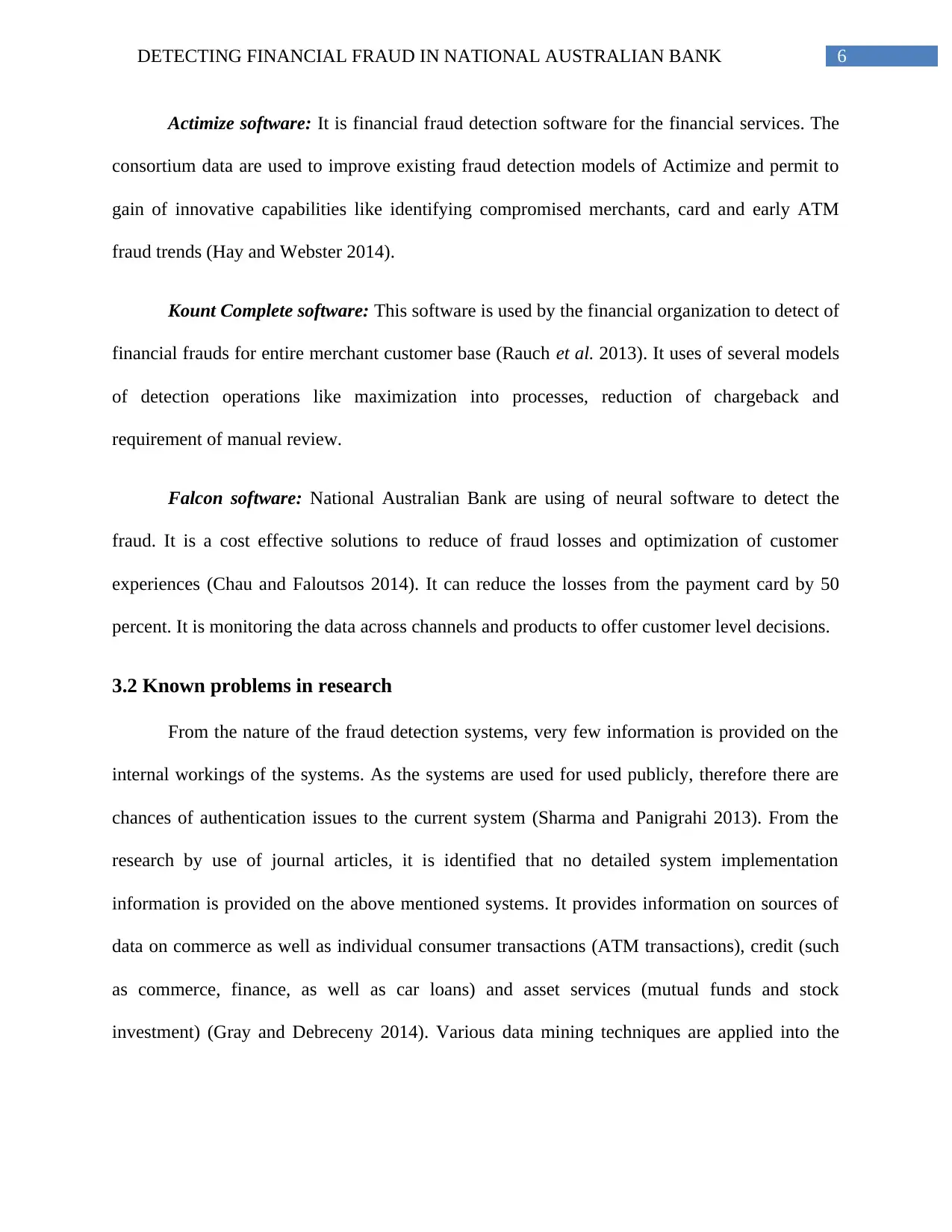
6DETECTING FINANCIAL FRAUD IN NATIONAL AUSTRALIAN BANK
Actimize software: It is financial fraud detection software for the financial services. The
consortium data are used to improve existing fraud detection models of Actimize and permit to
gain of innovative capabilities like identifying compromised merchants, card and early ATM
fraud trends (Hay and Webster 2014).
Kount Complete software: This software is used by the financial organization to detect of
financial frauds for entire merchant customer base (Rauch et al. 2013). It uses of several models
of detection operations like maximization into processes, reduction of chargeback and
requirement of manual review.
Falcon software: National Australian Bank are using of neural software to detect the
fraud. It is a cost effective solutions to reduce of fraud losses and optimization of customer
experiences (Chau and Faloutsos 2014). It can reduce the losses from the payment card by 50
percent. It is monitoring the data across channels and products to offer customer level decisions.
3.2 Known problems in research
From the nature of the fraud detection systems, very few information is provided on the
internal workings of the systems. As the systems are used for used publicly, therefore there are
chances of authentication issues to the current system (Sharma and Panigrahi 2013). From the
research by use of journal articles, it is identified that no detailed system implementation
information is provided on the above mentioned systems. It provides information on sources of
data on commerce as well as individual consumer transactions (ATM transactions), credit (such
as commerce, finance, as well as car loans) and asset services (mutual funds and stock
investment) (Gray and Debreceny 2014). Various data mining techniques are applied into the
Actimize software: It is financial fraud detection software for the financial services. The
consortium data are used to improve existing fraud detection models of Actimize and permit to
gain of innovative capabilities like identifying compromised merchants, card and early ATM
fraud trends (Hay and Webster 2014).
Kount Complete software: This software is used by the financial organization to detect of
financial frauds for entire merchant customer base (Rauch et al. 2013). It uses of several models
of detection operations like maximization into processes, reduction of chargeback and
requirement of manual review.
Falcon software: National Australian Bank are using of neural software to detect the
fraud. It is a cost effective solutions to reduce of fraud losses and optimization of customer
experiences (Chau and Faloutsos 2014). It can reduce the losses from the payment card by 50
percent. It is monitoring the data across channels and products to offer customer level decisions.
3.2 Known problems in research
From the nature of the fraud detection systems, very few information is provided on the
internal workings of the systems. As the systems are used for used publicly, therefore there are
chances of authentication issues to the current system (Sharma and Panigrahi 2013). From the
research by use of journal articles, it is identified that no detailed system implementation
information is provided on the above mentioned systems. It provides information on sources of
data on commerce as well as individual consumer transactions (ATM transactions), credit (such
as commerce, finance, as well as car loans) and asset services (mutual funds and stock
investment) (Gray and Debreceny 2014). Various data mining techniques are applied into the
Paraphrase This Document
Need a fresh take? Get an instant paraphrase of this document with our AI Paraphraser
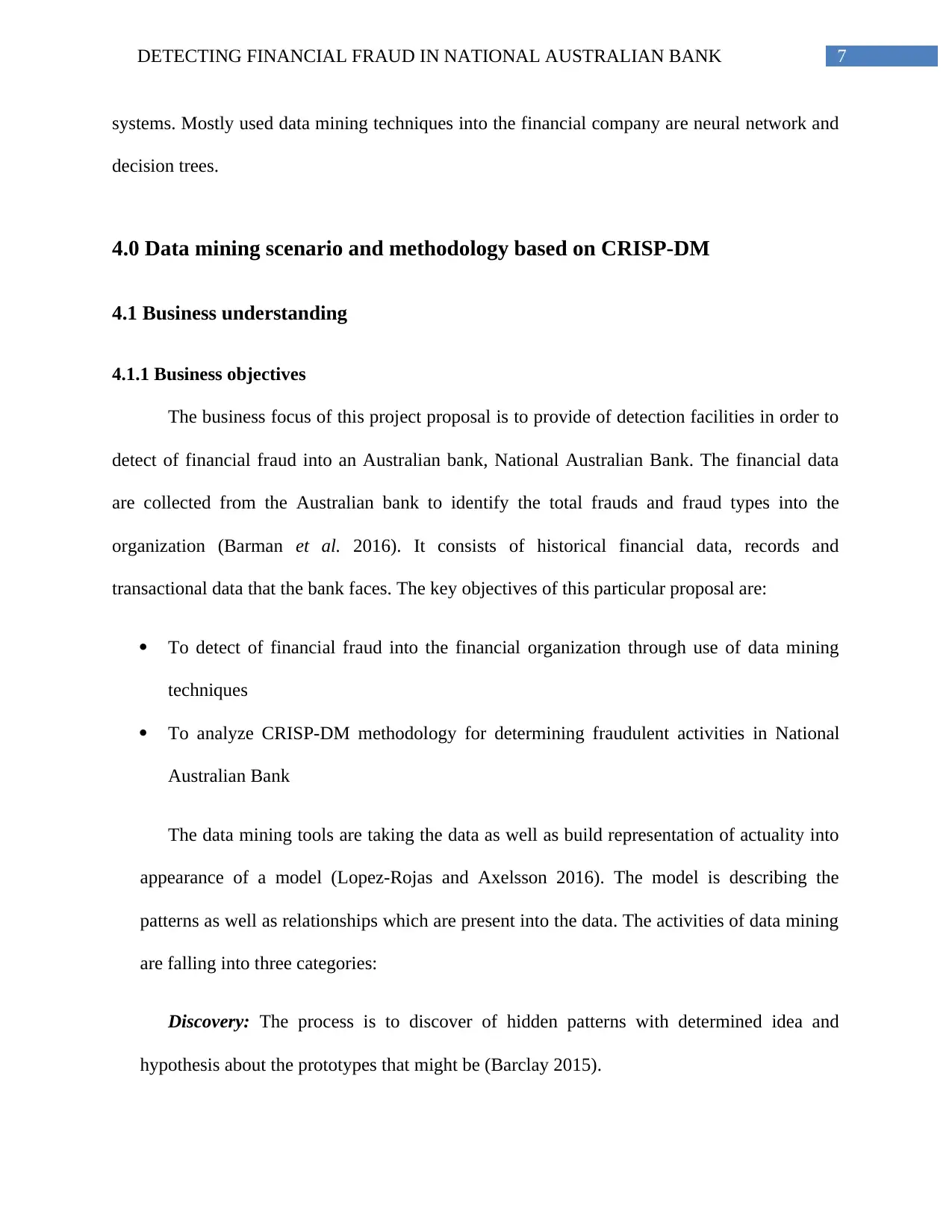
7DETECTING FINANCIAL FRAUD IN NATIONAL AUSTRALIAN BANK
systems. Mostly used data mining techniques into the financial company are neural network and
decision trees.
4.0 Data mining scenario and methodology based on CRISP-DM
4.1 Business understanding
4.1.1 Business objectives
The business focus of this project proposal is to provide of detection facilities in order to
detect of financial fraud into an Australian bank, National Australian Bank. The financial data
are collected from the Australian bank to identify the total frauds and fraud types into the
organization (Barman et al. 2016). It consists of historical financial data, records and
transactional data that the bank faces. The key objectives of this particular proposal are:
To detect of financial fraud into the financial organization through use of data mining
techniques
To analyze CRISP-DM methodology for determining fraudulent activities in National
Australian Bank
The data mining tools are taking the data as well as build representation of actuality into
appearance of a model (Lopez-Rojas and Axelsson 2016). The model is describing the
patterns as well as relationships which are present into the data. The activities of data mining
are falling into three categories:
Discovery: The process is to discover of hidden patterns with determined idea and
hypothesis about the prototypes that might be (Barclay 2015).
systems. Mostly used data mining techniques into the financial company are neural network and
decision trees.
4.0 Data mining scenario and methodology based on CRISP-DM
4.1 Business understanding
4.1.1 Business objectives
The business focus of this project proposal is to provide of detection facilities in order to
detect of financial fraud into an Australian bank, National Australian Bank. The financial data
are collected from the Australian bank to identify the total frauds and fraud types into the
organization (Barman et al. 2016). It consists of historical financial data, records and
transactional data that the bank faces. The key objectives of this particular proposal are:
To detect of financial fraud into the financial organization through use of data mining
techniques
To analyze CRISP-DM methodology for determining fraudulent activities in National
Australian Bank
The data mining tools are taking the data as well as build representation of actuality into
appearance of a model (Lopez-Rojas and Axelsson 2016). The model is describing the
patterns as well as relationships which are present into the data. The activities of data mining
are falling into three categories:
Discovery: The process is to discover of hidden patterns with determined idea and
hypothesis about the prototypes that might be (Barclay 2015).

8DETECTING FINANCIAL FRAUD IN NATIONAL AUSTRALIAN BANK
Predictive modeling: The development is to take of patterns exposed from record and
used it to forecast in the opportunity (Joudaki et al. 2015).
Forensic analysis: The process is to apply of extracted patterns to find out of anomalous
and extraordinary data elements.
4.1.2 Data mining goals
The key aim of the data mining tools are to present patterns that should indicate when
financial fraud are occurred, it allows the researcher to formulate of cases around highlighting
the frauds (Ahmed, Mahmood and Islam 2016). Data mining consists of patterns into larger data
sets involved of methods such as machine learning and database systems.
4.1.3 Project plan
This particular project plan highlights the steps of CRISP-DM methodology and the
respective working hours of the persons. This methodology provides with a structured approach
to plan this data mining project. The tools used in data mining are easing as well as it will
automate the process to discover kind of information from the larger stores of data. The entire
data mining project should complete within 2 months. The project plan is:
Serial
Number
Project Activities Person Hours
1 Business understanding
1.1 Conclude the business objectives 19
1.2 Data mining goals 12
1.3 Usage of data mining tools 5
Predictive modeling: The development is to take of patterns exposed from record and
used it to forecast in the opportunity (Joudaki et al. 2015).
Forensic analysis: The process is to apply of extracted patterns to find out of anomalous
and extraordinary data elements.
4.1.2 Data mining goals
The key aim of the data mining tools are to present patterns that should indicate when
financial fraud are occurred, it allows the researcher to formulate of cases around highlighting
the frauds (Ahmed, Mahmood and Islam 2016). Data mining consists of patterns into larger data
sets involved of methods such as machine learning and database systems.
4.1.3 Project plan
This particular project plan highlights the steps of CRISP-DM methodology and the
respective working hours of the persons. This methodology provides with a structured approach
to plan this data mining project. The tools used in data mining are easing as well as it will
automate the process to discover kind of information from the larger stores of data. The entire
data mining project should complete within 2 months. The project plan is:
Serial
Number
Project Activities Person Hours
1 Business understanding
1.1 Conclude the business objectives 19
1.2 Data mining goals 12
1.3 Usage of data mining tools 5
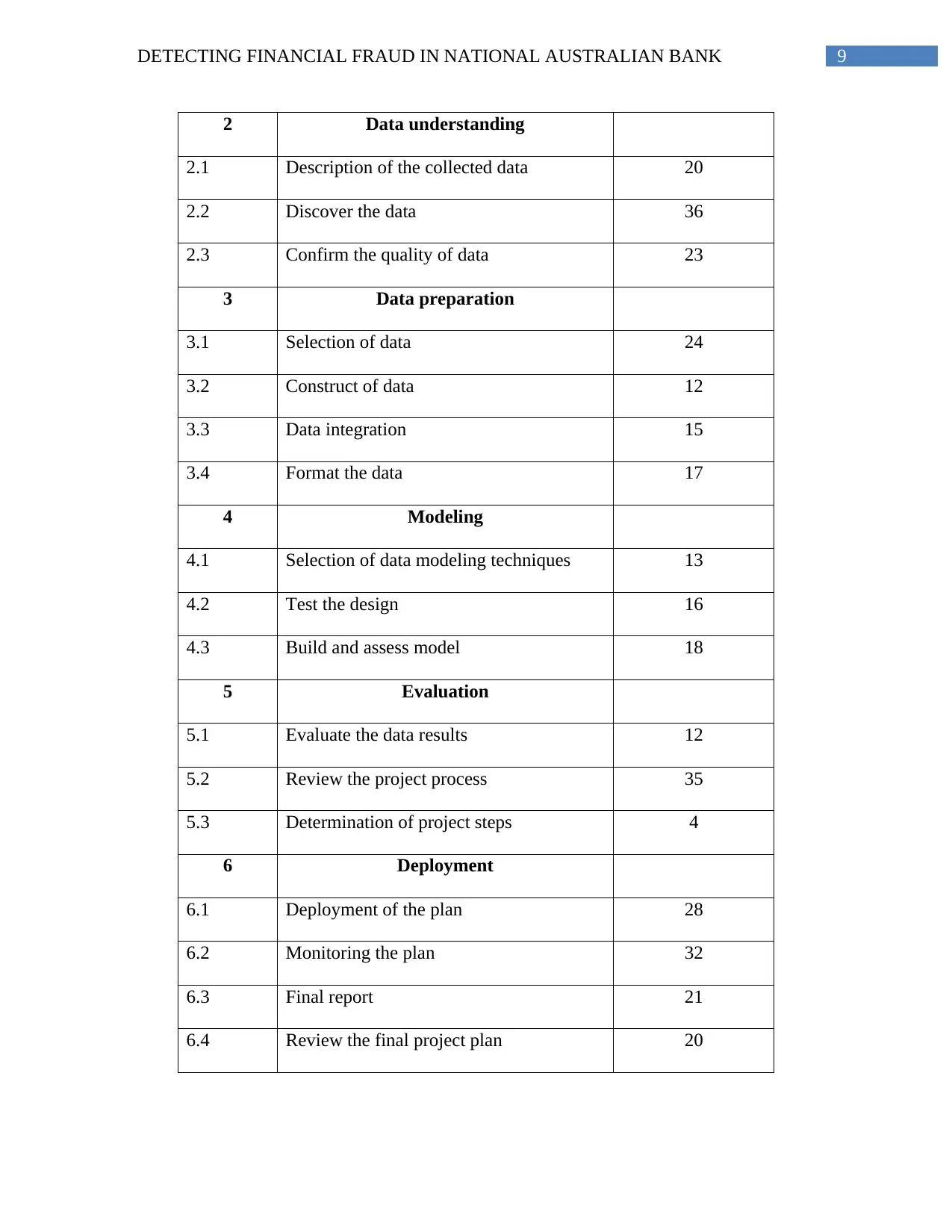
9DETECTING FINANCIAL FRAUD IN NATIONAL AUSTRALIAN BANK
2 Data understanding
2.1 Description of the collected data 20
2.2 Discover the data 36
2.3 Confirm the quality of data 23
3 Data preparation
3.1 Selection of data 24
3.2 Construct of data 12
3.3 Data integration 15
3.4 Format the data 17
4 Modeling
4.1 Selection of data modeling techniques 13
4.2 Test the design 16
4.3 Build and assess model 18
5 Evaluation
5.1 Evaluate the data results 12
5.2 Review the project process 35
5.3 Determination of project steps 4
6 Deployment
6.1 Deployment of the plan 28
6.2 Monitoring the plan 32
6.3 Final report 21
6.4 Review the final project plan 20
2 Data understanding
2.1 Description of the collected data 20
2.2 Discover the data 36
2.3 Confirm the quality of data 23
3 Data preparation
3.1 Selection of data 24
3.2 Construct of data 12
3.3 Data integration 15
3.4 Format the data 17
4 Modeling
4.1 Selection of data modeling techniques 13
4.2 Test the design 16
4.3 Build and assess model 18
5 Evaluation
5.1 Evaluate the data results 12
5.2 Review the project process 35
5.3 Determination of project steps 4
6 Deployment
6.1 Deployment of the plan 28
6.2 Monitoring the plan 32
6.3 Final report 21
6.4 Review the final project plan 20
Secure Best Marks with AI Grader
Need help grading? Try our AI Grader for instant feedback on your assignments.
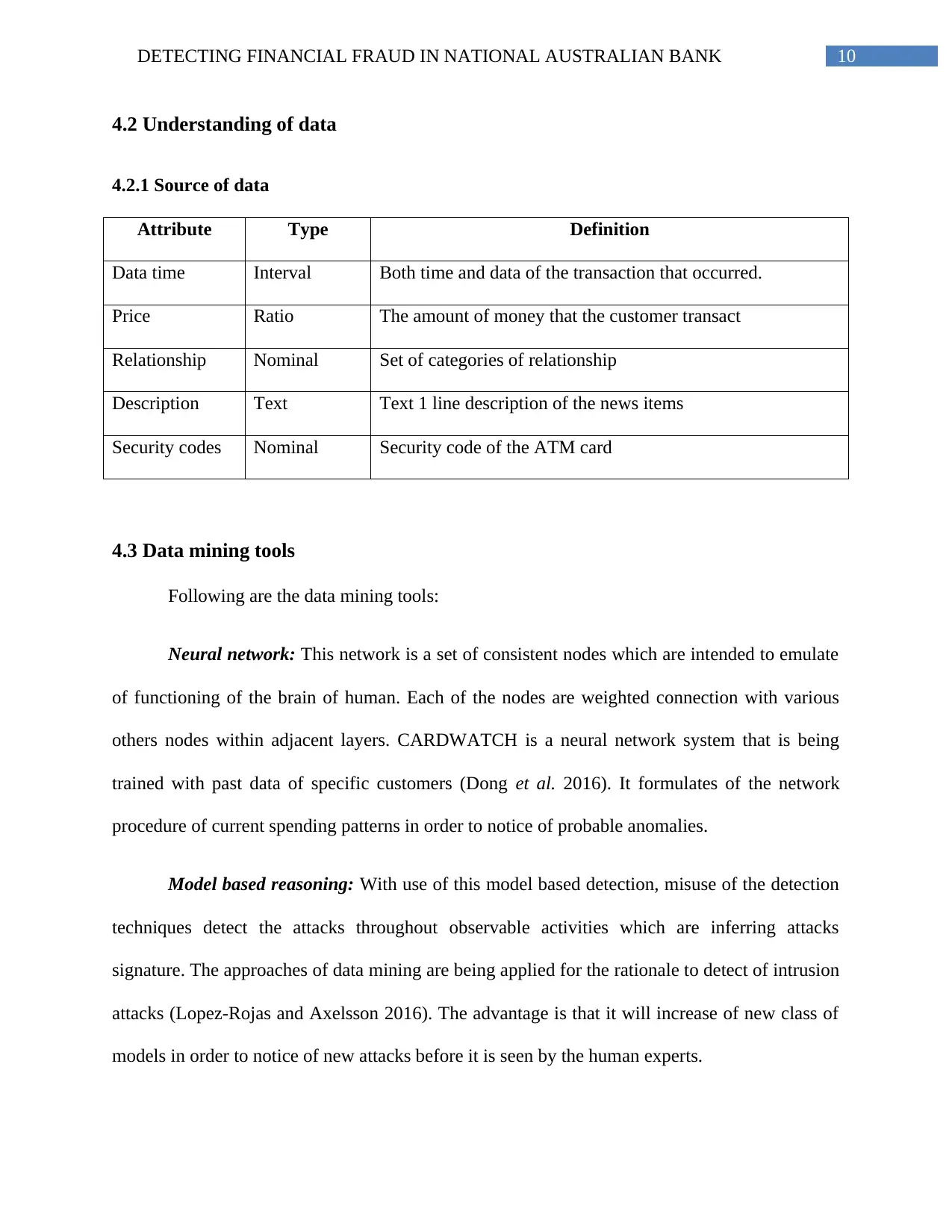
10DETECTING FINANCIAL FRAUD IN NATIONAL AUSTRALIAN BANK
4.2 Understanding of data
4.2.1 Source of data
Attribute Type Definition
Data time Interval Both time and data of the transaction that occurred.
Price Ratio The amount of money that the customer transact
Relationship Nominal Set of categories of relationship
Description Text Text 1 line description of the news items
Security codes Nominal Security code of the ATM card
4.3 Data mining tools
Following are the data mining tools:
Neural network: This network is a set of consistent nodes which are intended to emulate
of functioning of the brain of human. Each of the nodes are weighted connection with various
others nodes within adjacent layers. CARDWATCH is a neural network system that is being
trained with past data of specific customers (Dong et al. 2016). It formulates of the network
procedure of current spending patterns in order to notice of probable anomalies.
Model based reasoning: With use of this model based detection, misuse of the detection
techniques detect the attacks throughout observable activities which are inferring attacks
signature. The approaches of data mining are being applied for the rationale to detect of intrusion
attacks (Lopez-Rojas and Axelsson 2016). The advantage is that it will increase of new class of
models in order to notice of new attacks before it is seen by the human experts.
4.2 Understanding of data
4.2.1 Source of data
Attribute Type Definition
Data time Interval Both time and data of the transaction that occurred.
Price Ratio The amount of money that the customer transact
Relationship Nominal Set of categories of relationship
Description Text Text 1 line description of the news items
Security codes Nominal Security code of the ATM card
4.3 Data mining tools
Following are the data mining tools:
Neural network: This network is a set of consistent nodes which are intended to emulate
of functioning of the brain of human. Each of the nodes are weighted connection with various
others nodes within adjacent layers. CARDWATCH is a neural network system that is being
trained with past data of specific customers (Dong et al. 2016). It formulates of the network
procedure of current spending patterns in order to notice of probable anomalies.
Model based reasoning: With use of this model based detection, misuse of the detection
techniques detect the attacks throughout observable activities which are inferring attacks
signature. The approaches of data mining are being applied for the rationale to detect of intrusion
attacks (Lopez-Rojas and Axelsson 2016). The advantage is that it will increase of new class of
models in order to notice of new attacks before it is seen by the human experts.
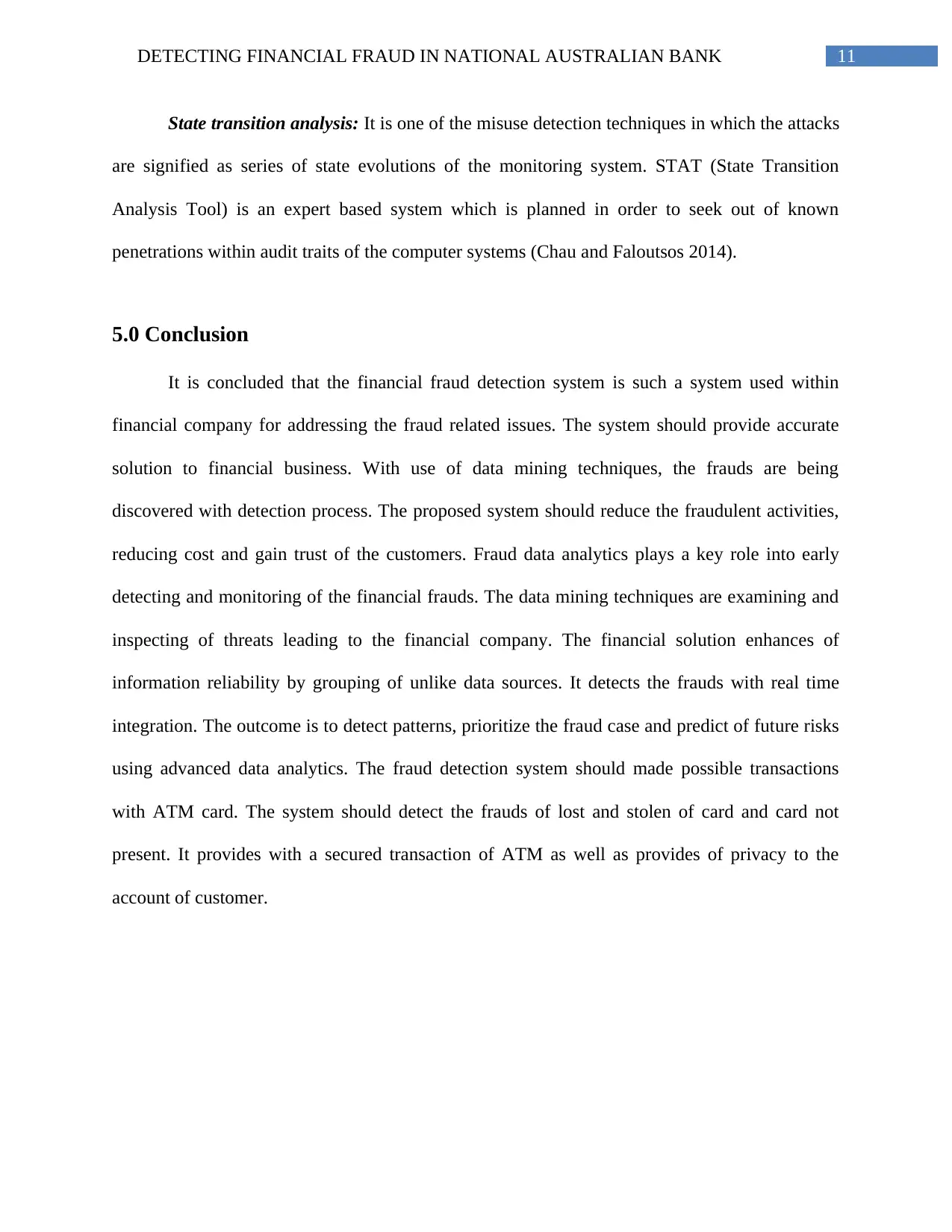
11DETECTING FINANCIAL FRAUD IN NATIONAL AUSTRALIAN BANK
State transition analysis: It is one of the misuse detection techniques in which the attacks
are signified as series of state evolutions of the monitoring system. STAT (State Transition
Analysis Tool) is an expert based system which is planned in order to seek out of known
penetrations within audit traits of the computer systems (Chau and Faloutsos 2014).
5.0 Conclusion
It is concluded that the financial fraud detection system is such a system used within
financial company for addressing the fraud related issues. The system should provide accurate
solution to financial business. With use of data mining techniques, the frauds are being
discovered with detection process. The proposed system should reduce the fraudulent activities,
reducing cost and gain trust of the customers. Fraud data analytics plays a key role into early
detecting and monitoring of the financial frauds. The data mining techniques are examining and
inspecting of threats leading to the financial company. The financial solution enhances of
information reliability by grouping of unlike data sources. It detects the frauds with real time
integration. The outcome is to detect patterns, prioritize the fraud case and predict of future risks
using advanced data analytics. The fraud detection system should made possible transactions
with ATM card. The system should detect the frauds of lost and stolen of card and card not
present. It provides with a secured transaction of ATM as well as provides of privacy to the
account of customer.
State transition analysis: It is one of the misuse detection techniques in which the attacks
are signified as series of state evolutions of the monitoring system. STAT (State Transition
Analysis Tool) is an expert based system which is planned in order to seek out of known
penetrations within audit traits of the computer systems (Chau and Faloutsos 2014).
5.0 Conclusion
It is concluded that the financial fraud detection system is such a system used within
financial company for addressing the fraud related issues. The system should provide accurate
solution to financial business. With use of data mining techniques, the frauds are being
discovered with detection process. The proposed system should reduce the fraudulent activities,
reducing cost and gain trust of the customers. Fraud data analytics plays a key role into early
detecting and monitoring of the financial frauds. The data mining techniques are examining and
inspecting of threats leading to the financial company. The financial solution enhances of
information reliability by grouping of unlike data sources. It detects the frauds with real time
integration. The outcome is to detect patterns, prioritize the fraud case and predict of future risks
using advanced data analytics. The fraud detection system should made possible transactions
with ATM card. The system should detect the frauds of lost and stolen of card and card not
present. It provides with a secured transaction of ATM as well as provides of privacy to the
account of customer.
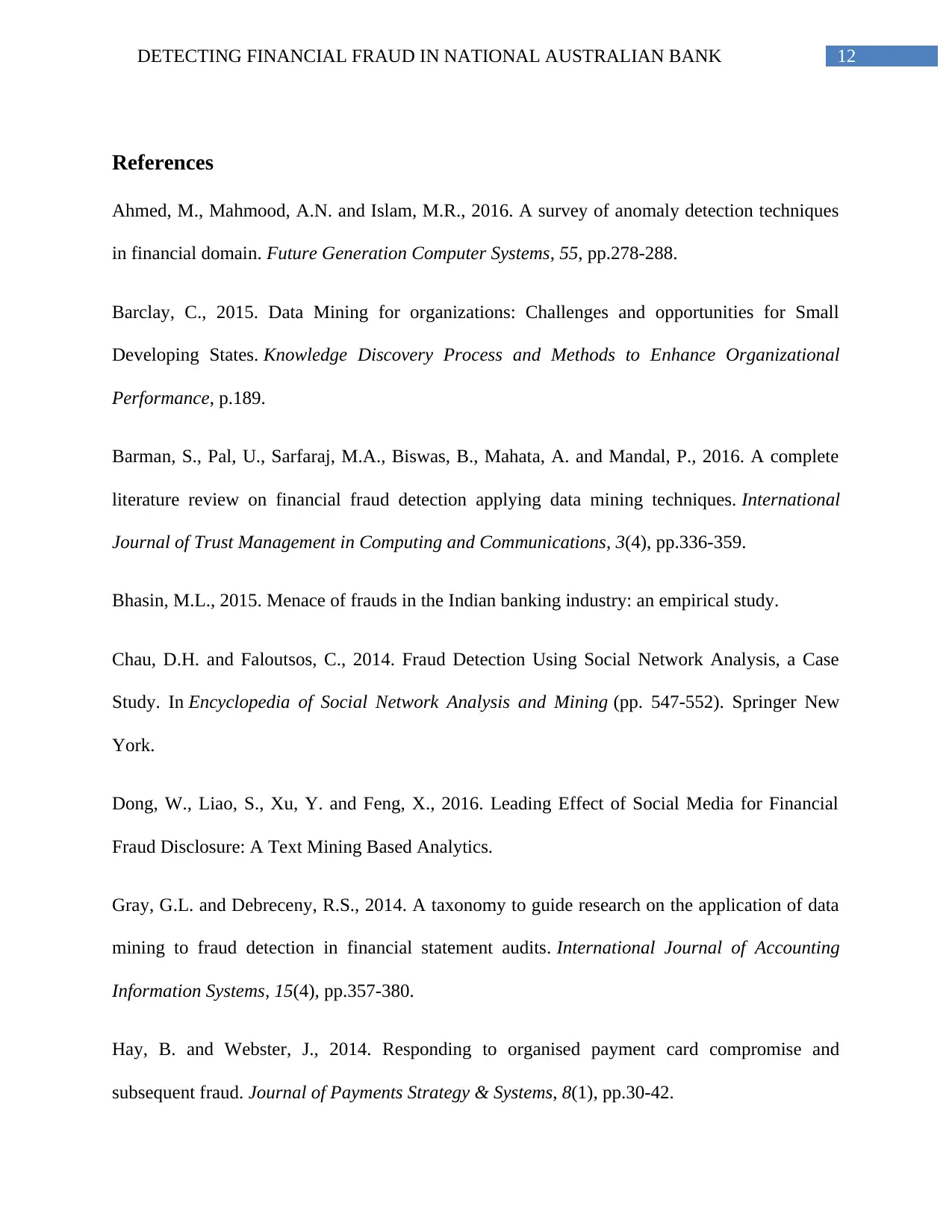
12DETECTING FINANCIAL FRAUD IN NATIONAL AUSTRALIAN BANK
References
Ahmed, M., Mahmood, A.N. and Islam, M.R., 2016. A survey of anomaly detection techniques
in financial domain. Future Generation Computer Systems, 55, pp.278-288.
Barclay, C., 2015. Data Mining for organizations: Challenges and opportunities for Small
Developing States. Knowledge Discovery Process and Methods to Enhance Organizational
Performance, p.189.
Barman, S., Pal, U., Sarfaraj, M.A., Biswas, B., Mahata, A. and Mandal, P., 2016. A complete
literature review on financial fraud detection applying data mining techniques. International
Journal of Trust Management in Computing and Communications, 3(4), pp.336-359.
Bhasin, M.L., 2015. Menace of frauds in the Indian banking industry: an empirical study.
Chau, D.H. and Faloutsos, C., 2014. Fraud Detection Using Social Network Analysis, a Case
Study. In Encyclopedia of Social Network Analysis and Mining (pp. 547-552). Springer New
York.
Dong, W., Liao, S., Xu, Y. and Feng, X., 2016. Leading Effect of Social Media for Financial
Fraud Disclosure: A Text Mining Based Analytics.
Gray, G.L. and Debreceny, R.S., 2014. A taxonomy to guide research on the application of data
mining to fraud detection in financial statement audits. International Journal of Accounting
Information Systems, 15(4), pp.357-380.
Hay, B. and Webster, J., 2014. Responding to organised payment card compromise and
subsequent fraud. Journal of Payments Strategy & Systems, 8(1), pp.30-42.
References
Ahmed, M., Mahmood, A.N. and Islam, M.R., 2016. A survey of anomaly detection techniques
in financial domain. Future Generation Computer Systems, 55, pp.278-288.
Barclay, C., 2015. Data Mining for organizations: Challenges and opportunities for Small
Developing States. Knowledge Discovery Process and Methods to Enhance Organizational
Performance, p.189.
Barman, S., Pal, U., Sarfaraj, M.A., Biswas, B., Mahata, A. and Mandal, P., 2016. A complete
literature review on financial fraud detection applying data mining techniques. International
Journal of Trust Management in Computing and Communications, 3(4), pp.336-359.
Bhasin, M.L., 2015. Menace of frauds in the Indian banking industry: an empirical study.
Chau, D.H. and Faloutsos, C., 2014. Fraud Detection Using Social Network Analysis, a Case
Study. In Encyclopedia of Social Network Analysis and Mining (pp. 547-552). Springer New
York.
Dong, W., Liao, S., Xu, Y. and Feng, X., 2016. Leading Effect of Social Media for Financial
Fraud Disclosure: A Text Mining Based Analytics.
Gray, G.L. and Debreceny, R.S., 2014. A taxonomy to guide research on the application of data
mining to fraud detection in financial statement audits. International Journal of Accounting
Information Systems, 15(4), pp.357-380.
Hay, B. and Webster, J., 2014. Responding to organised payment card compromise and
subsequent fraud. Journal of Payments Strategy & Systems, 8(1), pp.30-42.
Paraphrase This Document
Need a fresh take? Get an instant paraphrase of this document with our AI Paraphraser
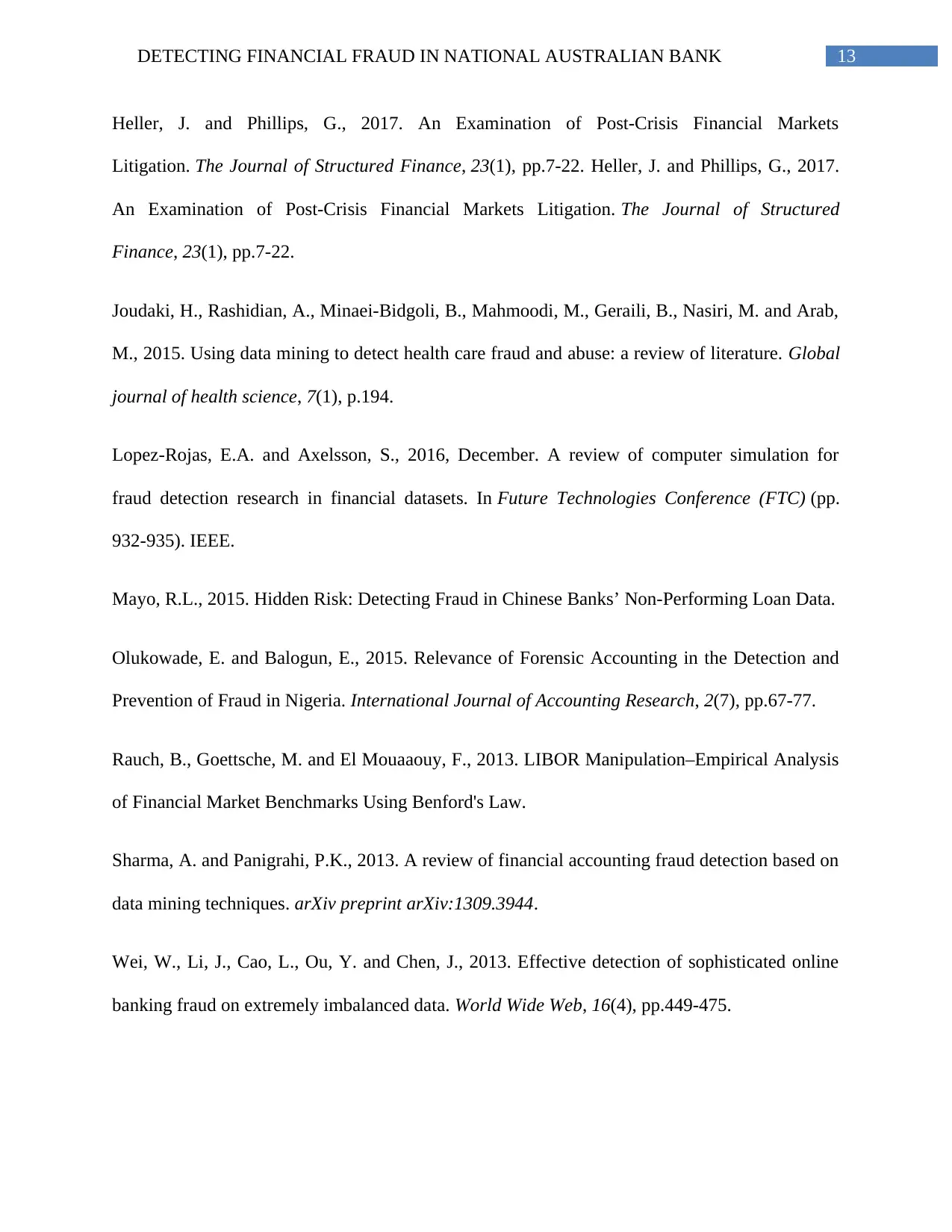
13DETECTING FINANCIAL FRAUD IN NATIONAL AUSTRALIAN BANK
Heller, J. and Phillips, G., 2017. An Examination of Post-Crisis Financial Markets
Litigation. The Journal of Structured Finance, 23(1), pp.7-22. Heller, J. and Phillips, G., 2017.
An Examination of Post-Crisis Financial Markets Litigation. The Journal of Structured
Finance, 23(1), pp.7-22.
Joudaki, H., Rashidian, A., Minaei-Bidgoli, B., Mahmoodi, M., Geraili, B., Nasiri, M. and Arab,
M., 2015. Using data mining to detect health care fraud and abuse: a review of literature. Global
journal of health science, 7(1), p.194.
Lopez-Rojas, E.A. and Axelsson, S., 2016, December. A review of computer simulation for
fraud detection research in financial datasets. In Future Technologies Conference (FTC) (pp.
932-935). IEEE.
Mayo, R.L., 2015. Hidden Risk: Detecting Fraud in Chinese Banks’ Non-Performing Loan Data.
Olukowade, E. and Balogun, E., 2015. Relevance of Forensic Accounting in the Detection and
Prevention of Fraud in Nigeria. International Journal of Accounting Research, 2(7), pp.67-77.
Rauch, B., Goettsche, M. and El Mouaaouy, F., 2013. LIBOR Manipulation–Empirical Analysis
of Financial Market Benchmarks Using Benford's Law.
Sharma, A. and Panigrahi, P.K., 2013. A review of financial accounting fraud detection based on
data mining techniques. arXiv preprint arXiv:1309.3944.
Wei, W., Li, J., Cao, L., Ou, Y. and Chen, J., 2013. Effective detection of sophisticated online
banking fraud on extremely imbalanced data. World Wide Web, 16(4), pp.449-475.
Heller, J. and Phillips, G., 2017. An Examination of Post-Crisis Financial Markets
Litigation. The Journal of Structured Finance, 23(1), pp.7-22. Heller, J. and Phillips, G., 2017.
An Examination of Post-Crisis Financial Markets Litigation. The Journal of Structured
Finance, 23(1), pp.7-22.
Joudaki, H., Rashidian, A., Minaei-Bidgoli, B., Mahmoodi, M., Geraili, B., Nasiri, M. and Arab,
M., 2015. Using data mining to detect health care fraud and abuse: a review of literature. Global
journal of health science, 7(1), p.194.
Lopez-Rojas, E.A. and Axelsson, S., 2016, December. A review of computer simulation for
fraud detection research in financial datasets. In Future Technologies Conference (FTC) (pp.
932-935). IEEE.
Mayo, R.L., 2015. Hidden Risk: Detecting Fraud in Chinese Banks’ Non-Performing Loan Data.
Olukowade, E. and Balogun, E., 2015. Relevance of Forensic Accounting in the Detection and
Prevention of Fraud in Nigeria. International Journal of Accounting Research, 2(7), pp.67-77.
Rauch, B., Goettsche, M. and El Mouaaouy, F., 2013. LIBOR Manipulation–Empirical Analysis
of Financial Market Benchmarks Using Benford's Law.
Sharma, A. and Panigrahi, P.K., 2013. A review of financial accounting fraud detection based on
data mining techniques. arXiv preprint arXiv:1309.3944.
Wei, W., Li, J., Cao, L., Ou, Y. and Chen, J., 2013. Effective detection of sophisticated online
banking fraud on extremely imbalanced data. World Wide Web, 16(4), pp.449-475.
1 out of 14
Related Documents
Your All-in-One AI-Powered Toolkit for Academic Success.
+13062052269
info@desklib.com
Available 24*7 on WhatsApp / Email
![[object Object]](/_next/static/media/star-bottom.7253800d.svg)
Unlock your academic potential
© 2024 | Zucol Services PVT LTD | All rights reserved.




